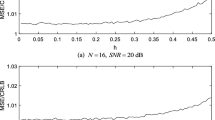Abstract
In wireless receivers, in order to prevent the saturation of a received signal in an analog-to-digital converter (ADC), an automatic gain control (AGC), which maintains the amplitude of an analog signal at an appropriate fixed level, is frequently employed. This paper discusses the effects of gain control and quantization in the AGC and ADC on the receiver performance in frequency division multiplexing-based narrowband communication systems. Each communication channel is very narrow in these systems, so the channels are packed without breaks, making it difficult to extract the desired signal using an analog bandpass filter. Therefore, other multiple communication signals are in-band interference signals in these systems. In comparison with a single interference signal, a peak amplitude of multiple interference signals is greater than the that of single interference signal given the same interference power. It is well known that signals having a large peak value cause the degradation of bit resolution due to the AGC and ADC processes. The purpose of this paper is to provide a theoretical and numerical analysis of the effects of gain control and quantization on the receiver performance in such an environment. The analysis results indicated that (i) in-band interference signals decreased the bit resolution of the desired signal amplitude because of these processes and (ii) the effects of these processes depend on the amplitude intensity and the number of in-band interference signals, given the same interference power.











Similar content being viewed by others
References
ARIB STANDARD. (2006). RCR STD-15 (in Japanese) .
ARIB STANDARD. (2006). RCR STD-21 (in Japanese).
Crols, J., & Steyaert, M. S. J. (1998). Low-IF topologies for high-performance analog front ends of fully integrated receivers. IEEE Transactions on Circuits and Systems II: Analog and Digital Signal Processing, 45(12), 269–282.
Xu, Y., Qi, N., Chen, Z., Chi, B., & Wang, Z. (2012). A hybrid approach to I/Q imbalance self-calibration in reconfigurable low-IF receivers. In Proceedings of the IEEE international symposium on circuits and systems 2012 (IEEE ISCAS 2012) (pp. 552–555).
Jou, S.-J., Wu, S.-Y., & Wang, C.-K. (1998). Low-power multirate architecture for IF digital frequency down converter. IEEE Transactions on Circuits and Systems II: Analog and Digital Signal Processing, 45(11), 1487–1494.
Liu, K., Denno, S., Furuno, T., & Morikura, M. (2010). Image-band interference cancellation for multi-mode/band receivers with baseband AGC. In Proceedings of the IEEE vehicular technology conference 2010 (IEEE VTC 2010-Spring) (pp. 1–5).
Kim, M.-S., Jo, G.-D., & Kim, J.-U. (2008). Optimal detection considering AGC effects in multiple antenna systems. In Proceedings of the IEEE interantional symposium on consumer electronics 2008 (IEEE ISCE 2008) (pp. 1–4).
Murray B. M., & Collings, I.B. (2006). AGC and quantization effects in a zero-forcing MIMO wireless system. In Proceedings of the IEEE vehicular technology conference 2006 (IEEE VTC 2006-Spring) (pp. 1802–1806).
Shi, K., Zhou, Y., Kelleci, B., Fischer, T. W., Serpedin, E., & Karşılayan, A. İ. (2007). Impacts of narrowband interference on OFDM-UWB receivers: Analysis and mitigation. IEEE Transactions on Signal Processing, 55(3), 1118–1128.
Namgoong, W. (2001). ADC and AGC requirements of a direct-sequence spread spectrum signal. In Proceedings of the IEEE midwest symposium on circuits and systems 2001, (IEEE MWSCAS 2001), vol. 2, pp. 744–747.
Razavi, B. (1998). RF microelectronics. Englewood: Prentice Hall.
Perez, J. P. A., Pueyo, S. C., & Lopez, B. C. (2011). Automatic gain control, techniques and architectures for RF receivers. Berlin: Springer.
Cover, T. M., & Thomas, J. A. (1991). Elements of information theory. New York: Wiley.
Author information
Authors and Affiliations
Corresponding author
Rights and permissions
About this article
Cite this article
Narieda, S. Receiver Performances Considering Effects of Gain Control and Quantization in FDM-Based Narrowband Communication Systems. Wireless Pers Commun 78, 741–754 (2014). https://doi.org/10.1007/s11277-014-1781-4
Published:
Issue Date:
DOI: https://doi.org/10.1007/s11277-014-1781-4




